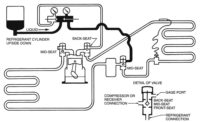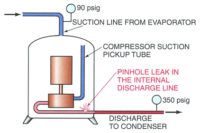The dispatcher calls Bob and explains that a new customer has called and complained that their heat pump is blowing cold air and not heating the house very well. It is the first cold weather of the season.
Bob thinks he knows what the problem is and is thinking it over as he rides to the job. He thinks that the electric heat is not coming on during the defrost cycle. Some manufacturers do not operate the electric heat during defrost to improve the unit's seasonal energy efficiency ratio (SEER). When the system is in defrost, the unit is actually in the cooling mode for that time span and if the customer is standing in the airflow it will be cool.
Bob arrives at the job with a plan only to find that he has drawn the wrong conclusion. When he talks to the customer, she explains, "We moved here to the South from New York and our heating system there blew hot air during the heating cycle. This system seems to keep the house comfortable, but it always blows cool air. For example, I like to sit and sew by the large window in the den and the air blows on me and I am cold. The bathroom air outlet blows cold air and is very uncomfortable when we are just out of the shower."
Bob looks at the arrangement in the sewing area first. The sewing chair is practically sitting on the floor register. He is standing there thinking when Btu Buddy says to him, "Bob, remember that a heat pump's outlet air temperature is normally in the range of 100 degrees F when just the compressor is doing the heating. This home that these people have bought has a heat pump that is about three years old and it is not practical to change the system. The customer needs a heat pump education. Just think and advise using common sense."
Bob then says to the customer, "You are used to a very different type of heating system than the heat pump you have. For example, the maximum air temperature from the heat pump when the auxiliary electric heat is not operating is about 100 degrees F. When that 100 degree F air is mixed with the room air, before it reaches your skin it could easily be 80 to 85 degrees F. Skin temperature is typically around 90 degrees F. When 85 degree F air blows on 90 degree F skin, it seems cool. It will still heat the house to a comfortable 75 degrees F, but blowing on your skin, it can seem uncomfortable. The furnaces that you have up north are usually gas or oil. The air temperature out of them can easily be 120 to 140 degrees F. When that air reaches your skin, it is typically above skin temperature."
She then asks, "Isn't body temperature 98.6 degrees F?"
Bob explains, "Yes, but that is the trunk of your body, not the outer extremities like your arms, legs, hands, and feet. They are much cooler than the trunk of your body."
"Well, what can be done to be comfortable in our house?" she asks.

Making Adjustments To A Heat Pump System
Bob responds, "Now that you know what the differences are in heating systems, let's see if we can do something in the den first. We can move your chair over a few inches and that will help some. This is a floor register and it is supposed to distribute the air. The air should be directed towards the wall to help warm the wall so it won't cool the room (Figure 1). I am going to turn the register around 180 degrees and point the air away from your chair and more toward the wall. I think this will help a great deal in this room."She asks, "Why don't we just shut that register off?"
Bob explains, "You could probably do that, but it will not help the efficiency of the whole system, which depends on all of the airflow to operate at peak efficiency. It might also cause the room temperature to drop."
Bob then suggests that they move to the bathroom problem. When he looks at it he turns the unit fan to the "on" position to see how much air is coming out of the register. He then explains, "The company installed a low side wall register in here to keep from using the tile floor. A side wall register is not a good choice in a small room, but sometimes it is what is used (Figure 2). This one seems to have too much airflow. I am going under the house to see if I can regulate the airflow a little lower using the damper to that run."

Bob goes back into the bathroom with the owner. She says, "That really reduced the airflow in here. Do you think it will heat it now?"
Bob says, "Yes, I think it will. Something else that you may consider is using a small ceiling-mount electric radiant heater. You have probably seen them in motel bathrooms. That would give you that warm feeling when just getting out of the shower. It would have to be installed by an electrician."
Bob then resets the fan switch on the thermostat to the "Auto" position.
Bob then asks, "Are there any more areas that are uncomfortable?"
She says, "No, I think that is it. I now have an idea of how to deal with a different type of heating system and know what to look for, thank you."
Btu Buddy says as they are leaving, "Good job Bob, getting the customer to understand the system was a real help in this case. Using your good judgment definitely helped on this job. You are getting better and better at customer relations and service work. Customer relations is a big part of having a happy customer."
Bill Johnson has been active in the HVACR industry since the 1950s. He graduated in gas fuel technology and refrigeration from the Southern Technical Institute, a branch of Georgia Tech (now known as Southern Polytechnic Institute). He taught HVAC classes at Coosa Valley Vocational & Technical Institute for four years. He moved on to become service manager for Layne Trane, Charlotte, N.C. He taught for 15 years at Central Piedmont Community College, part of this time as program director. He had his own business for five years doing installation and service work. Now retired, he is the author of Practical Heating Technology and Practical Cooling Technology, and continues as a co-author of Refrigeration & Air Conditioning Technology, 5th Edition, all published by Delmar Publishers. For more information, he can be reached at 704-553-0087, 704-643-3928 (fax), or billj@carolina.rr.com.
Publication date: 10/17/2005









